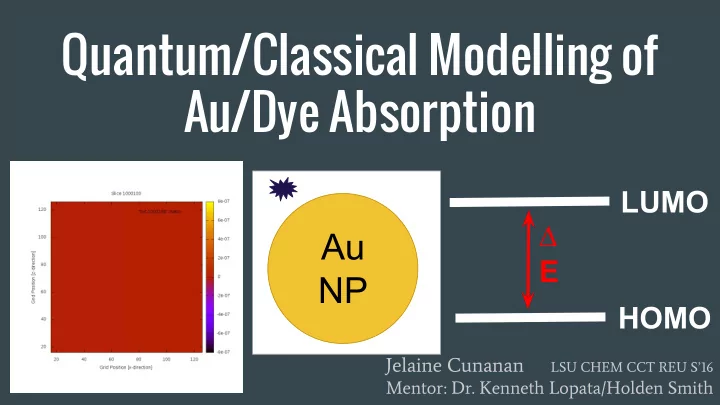

Quantum/Classical Modelling of Au/Dye Absorption LUMO ∆ Au E NP HOMO Jelaine Cunanan LSU CHEM CCT REU S’16 Mentor: Dr. Kenneth Lopata/Holden Smith
Importance 1. Bio / Chemical Sensors 2. Catalysis (Photochemistry) ○ Chemical Rxns at Surface 3. Light Harvestry
Optical Absorption ∆E = hv LUMO Light In Light Out ∆E Energy where light is absorbed HOMO
Metal + Molecule Absorption l e D y e m o l e c u 100nm NP Light energy Computer Simulations of Light Absorption in Au nanoparticle coated with dye molecules
Au Requires QM Challenges NP 10 6 atoms 1. Dye molecules require D y e m Quantum Mechanics o l e c (QM) u l e 2. Au NP is too large for QM Too large for QM!
Au Overall Goals NP Quantum Mechanics 10 6 atoms 1. Develop tools for Quantum/Classical Simulations 2. Model Coupled excitements of Au Classical Electrodynamics nanoparticles & dyes (electric & magnetic fields)
My Objectives LUMO 1. Develop code for 2-level QM molecule 2. Parameterize model using Time-Dependent Density ∆E Functional Theory (TDDFT) eg: HOMO-LUMO gap 3. Integrate into electrodynamic HOMO code using finite-difference time domain (FDTD)
Results (FDTD) Gridpoint Grid spacing Gold Nanoparticle
Results (FDTD) Malachite Green Dye Molecule
Results (FDTD) Distance ~2.5nm Gold Nanoparticle/Dye Molecule Coupled Simulations
Results (FDTD) Gold Nanoparticle/Dye Molecule Coupled Simulations
Results (FDTD) Gold Nanoparticle/Dye Molecule Coupled Simulations
Acknowledgments ➔ Dr. Kenneth Lopata ➔ Holden Smith ➔ Adam Bruner ➔ NSF REU ➔ CCT
Recommend
More recommend